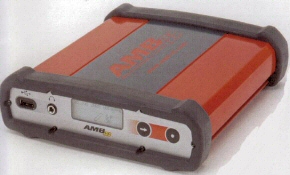Transponder
Timing Systems
We
get quite a few emails about transponder timing
systems, so this page has been created to give
some information that a club/track might find
useful.
Three
companies produce systems designed to automatically
time/score RC cars, other systems are available
but are for personal use or mini scale (min-z
etc).
AMB
have been the market leader in this sector since
the early 80's when they invented a timing computer
and then a transponder timing system for model
cars, they now produce systems for all kinds
of sports (there is a history on their web site).
The
System 20 (called this because
it can count twenty cars) was introduced in
the early 90's, these are no longer made but
are available on the second hand market. The
basic system can count 10 cars but with an additional
box can count 20, many earlier systems sold
by AMB (8300/8800 models) could be converted
to use system 20 transponders and many of these
systems are still used today. Only rechargeable
transponders were available for system 20, a
club/track will normally have two sets( one
for the current race and a set to be given out
for the next), of course some drivers forget
to return transponders which causes problems.
AMBrc
systems were introduced in the year 2000 to
replace the popular System 20, the new system
introduced the ability to have personal transponders
as well as handout rechargeable's (System 20
transponders will not work on AMBrc systems
or visa-versa). Every driver can now have a
transponder permanently installed in their car
powered by the onboard electronics (3rd channel
or battery connector), removing the need to
take and return a track/club one.
AMBrc3
decoders were introduced in mid 2006
and use the same "Red" transponders
as the AMBrc system. The front of the unit has
an LCD screen, two buttons to edit settings,
a headphone socket and a USB A Socket that is
disabled at the present time. At the rear there
is a power socket, 10/100 ethernet connection
(RJ45), RS232, Auxiliary and loop coax connection.
AMBrc3 decoders do not have a USB B connection,
instead an Ethernet 10/100 network connection
is provided; this means that the decoder must
be powered by a separate mains adaptor. This
may be seen by many users of AMBrc as a backwards
step but I believe that the power requirements
of the new decoder are too great for USB. Ethernet
does have its advantages over USB however, a
more secure connection (will not drop out if
the computer goes into power saving) and allows
for up to four computers to be connected at
the same time. Ethernet also allows the decoder
to work independently of a computer to upload
lap times via AMB's mylaps live service, just
plug the decoder into a adsl/cable router, enter
the mylaps username/password and your away,
amazing!
Apart
from the my laps live service there is little
practical difference between the AMBrc / AMBrc3
decoders, that latest features though will be
useful for those that must have their results
"live" on the internet.

Chronit
produced a system very similar to AMB's, but
they are no longer in existence.
KO
Propo have released two systems onto the
market, one works with Mini-Z cars and uses
the signals emitted by the receiver unit to
count the cars. The other system uses transponder
type units (Called TD-1), powered by a free
slot in the cars receiver. To change the transponder
number different crystals are installed, so
the system requires some driver involvement
and a large collection of crystals, unless they
have to be returned after every race.
A
transponder system is a significant purchase,
make sure that the system you want to buy is
suitable for your purpose, visiting another
track might be a good idea to see the system
being used.
